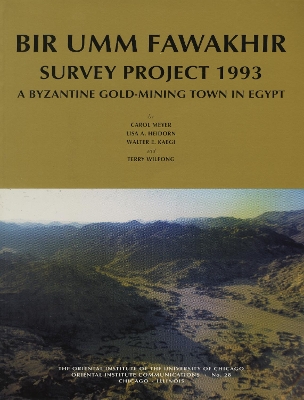Oriental Institute Communications
2 primary works
Book 28
Bir Umm Fawakhir Survey Project 1993
by Lisa A. Heidorn, W. E. Kaegi, Carol Meyer, and Terry G. Wilfong
Published 1 December 2000
The Oriental Institute continued its survey of Bir Umm Fawakhir, a site lying half way between the Nile and the Red Sea, with a short season in January 1993. Located close to the famous bekhen-stone quarries and graffiti of the Wadi Hammamat, the 1992 project took the form of a geological study of the area of Bir Umm Fawakhir. The presence of these mineral resources in this otherwise barren hyper-arid desert, explains why the Bir Umm Fawakhir town was established in this area. By far the most valuable resource was the gold carried in white quartz veins in the local granite, and the mountainsides around Bir Umm Fawakhir are riddled and trenched with ancient mines. This report reflects on the aims of the 1993 season which was to continue mapping the site, to expand the pottery corpus, to seek for some specific features not found in 1992 such as defensive structures and churches, and to carrry out a more general survey of the site's immediate vicinity.
Book 30
Bir Umm Fawakhir, Volume 2
by Lisa Heidorn, Lisa A. Heidorn, Carol Meyer, Alexandra A. O'Brien, Clemens Reichel, and Clemens D. Reichel
Published 2 September 2011
Bir Umm Fawakhir is a fifth-sixth century AD Coptic/Byzantine gold-mining town located in the central Eastern Desert of Egypt. The Bir Umm Fawakhir Project of the Oriental Institute of the University of Chicago carried out four seasons of archaeological survey at the site, in 1992, 1993, 1996, and 1997; one season of excavation in 1999; and one study season in 2001. This volume is the final report on the 1996 and 1997 seasons. The goals of the 1996 and 1997 field seasons were to complete the detailed map of the main settlement, to continue the investigation of the outlying clusters of ruins or "Outliers" and to address some specific questions such as the ancient gold-extraction process. The completion of these goals makes the main settlement at Bir Umm Fawakhir one of the only completely mapped towns of the period in Egypt. Not only is the main settlement plotted room for room and door for door but also features such as guardposts, cemeteries, paths, roads, wells, outlying clusters of ruins and mines are known and some of these are features not always readily detectable archaeologically. This volume presents the pre-Coptic material; a detailed discussion of the remains in the main settlement, outliers and cemeteries; the Coptic/Byzantine pottery, small finds and dipinti; as well as a study of ancient mining techniques.

